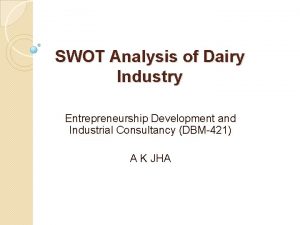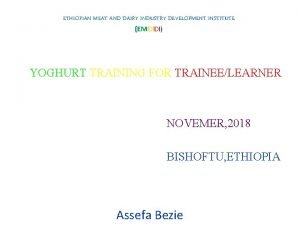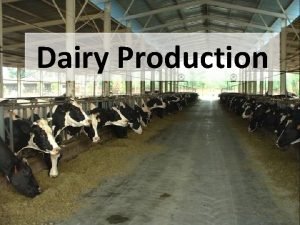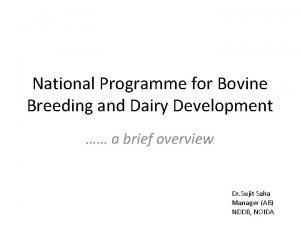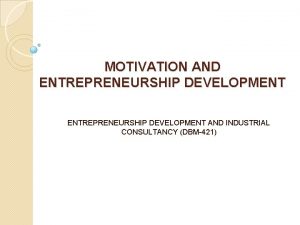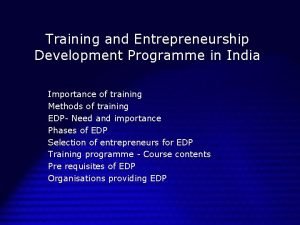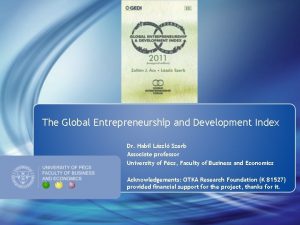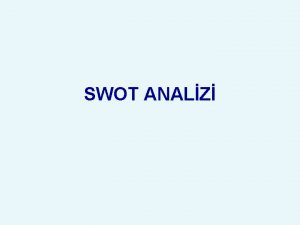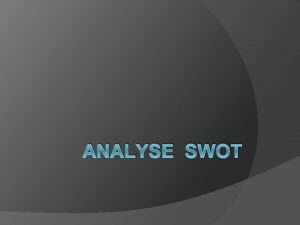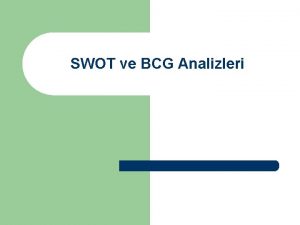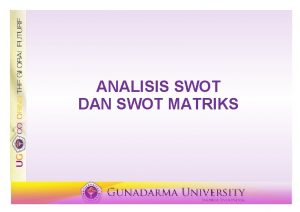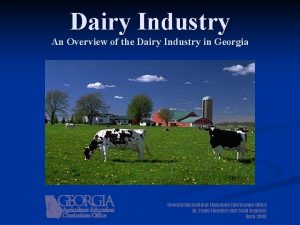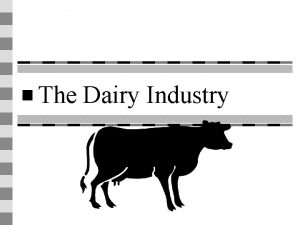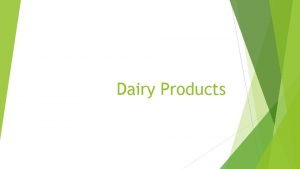SWOT Analysis of Dairy Industry Entrepreneurship Development and













- Slides: 13

SWOT Analysis of Dairy Industry Entrepreneurship Development and Industrial Consultancy (DBM-421) A K JHA

INTRODUCTION SWOT Analysis �In SWOT Analysis: ◦ ◦ S implies for Strength W indicates Weakness O stands for Opportunities and T stands for Threat �SWOT analysis is the analysis of organization’s or company’s strengths, weaknesses, opportunities and threats.

IMPORTANCE OF SWOT ANALYSIS �SWOT Analysis helps in identifying and understanding the internal and external factors faced by the organization. § Internal factors include strength and weaknesses § Opportunities and threats are external factors. � SWOT analysis is helpful in deciding about the firms' resources and capabilities § In accordance with the competitive environment in which it operates and § is therefore an important contribution to the strategic planning process. �It is a dynamic process because the business environments keep on changing.

Importance and Uses of SWOT Analysis �SWOT analysis provides information on an organisation's Strengths and Weaknesses after based on analysis of its resources and capabilities. �It also provides a list of Threats and Opportunities after an analysis of its environment. �The future strategy should be built to capitalize the strengths for harnessing the opportunities by addressing threats and overcoming weaknesses.

Guidelines for Preparing SWOT Matrix �Opportunity and Threat Matrices ◦ helps in assessment of the ‘likelihood probability’ and ‘impact’ of such factors on the organisation. �A scoring system may be used to assign importance to factors. ◦ A factor which have a high score on both 'probability of occurrence' and 'likely impact on the organisation or business', needs close attention and play a significant part in the development of a strategic plan. �In the same manner, strengths and weaknesses should be assessed by using a scoring approach to identify the factors according to their significance (i. e. major, minor, neutral) and level of importance (high, medium, low).

Guidelines for Preparing SWOT Matrix �Involve people who have experience and knowledge in the analysis to identify the factors. �The outcome of the analysis is the matrix ◦ that presents the most important strengths, weaknesses, opportunities and threats for the organization ◦ so that major issues can be taken into account when subsequently drawing up strategic plans for an organization. �It is possible to represent this analysis in a Performance-Importance matrix. �A SWOT analysis is based on hard facts. These can be time-consuming and costly to gather.

Drawbacks of SWOT Analysis �The length of the lists of factors that have to be taken into account in the analysis �Lack of prioritisation of factors ◦ there being no requirement classification and evaluation for their �No suggestions for solving disagreements �No obligation to verify statements or aspects based on the data or the analysis �Analysis only at a single level �Over-subjectivity in the generation of factors ◦ the use of ambiguous and vague words and phrases

Strengths of Dairy Industry � Enhanced milk production- 187. 7 million tons (2018 -19 -NDDB) ◦ with consequently increased availability of milk processing (394/gm/person/day) � Increased purchasing power of the consumer. � Improved transportation facilities for movement of milk and milk products. � Increased availability of indigenously manufactured equipment. � Large number of dairy plants in the country. � Vast pool of highly trained and qualified manpower available to the industry. � Country's vast natural resources offer immense potential for growth and development of dairying.

Weaknesses of Dairy Industry �Lack of appropriate technologies for tropical climate conditions. �Erratic power supply. �Lack of awareness for clean milk production. �Underdeveloped raw milk collection systems in certain parts of the country. �Seasonal fluctuations in milk production pattern. �Regional imbalance of milk supply. �Species-wise variation in milk quality received by dairy plants. �Poor productivity of cattle and arable land.

Weaknesses of Dairy Industry �Scarce capital for investment in the dairy development programmes on a priority basis. �Absence of proper data records which is essential for preparing development programmes. �Dairy development programmes have not been fully implemented as per the needs of the region in different agro-climatic zones. �Lack of marketing avenues for the dairy produce. �Lack of software for preparing needed dairy schemes/projects.

Opportunities � Greatly improved export potential for milk products of western as well as traditional types. � Expanding market for traditional dairy products. � Increasing demand for fluid milk as well as value added products. � By product utilization for import substitution. � Employment generation. � Growing demand for milk and milk products. � Liberalized polices in dairy sector. � Availability of large resources of unconventional feeds and fodders. � Availability of diverse germplasm with unique features like heat tolerance, disease resistance, draftability and ability to survive and produce under stress conditions.

Opportunities � Availability of animal production technologies for faster development and effective implementation. � Integrated structure of marketing for milk and milk products. � Integrated structure of livestock marketing through regulated markets. � Improved collection of data on contract basis through agencies. � Market information intelligence system for milk and milk products. � Development of software for project formulation for dairy enterprise.

Threats � Introduction of foreign products in Indian market. � Increasing chemical contaminants and residual antibiotics in milk. � Poor microbiological quality of milk. � Export of quality feed ingredients particularly cakes under the liberalization policy. � Deficiency of molasses, a rich source of energy and binding agent in feed industry and constituent of urea molasses mineral lick. � Excessive grazing pressure on marginal and small community lands resulting in complete degradation of land. � Extinction of the indigenous breeds of cattle due to indiscriminate use of crossbreeding programme to enhance milk production. � The liberalization of the dairy industry is likely to be exploited by multinationals. They will be interested in manufacturing value added products. It will create milk shortage in the country adversely affecting the consumers.
 Swot analysis for dairy industry
Swot analysis for dairy industry Emdidi
Emdidi Swot analysis for game development
Swot analysis for game development Swot analysis of mice industry
Swot analysis of mice industry Swot analysis of apparel industry
Swot analysis of apparel industry Swot analysis of textile industry in pakistan
Swot analysis of textile industry in pakistan Introduction to entrepreneurship module
Introduction to entrepreneurship module Objectives of dairy industry
Objectives of dairy industry Wastewater treatment for dairy industry
Wastewater treatment for dairy industry Npbb maitri
Npbb maitri Coop swot
Coop swot Motivation and entrepreneurship development
Motivation and entrepreneurship development Edp course contents
Edp course contents Global entrepreneurship and development index
Global entrepreneurship and development index
